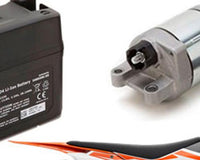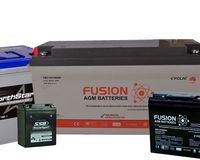Table of Contents
A button cell resembles a button, thus the name. It’s a single-cell battery often used to power small devices like hearing aids and wristwatches.
Its diameter ranges between five to 25 mm (0.197 to 0.984 inches), while its height dimensions are between 1 and 6 mm (0.039 to 0.236 inches).
The battery has two terminals:
- The positive terminal is composed of stainless steel and lies at the bottom.
- The negative terminal is insulated and forms the top cap.
Button cells are famous for their longevity. They possess a low self-discharge, which allows them to keep their charge for a long time (especially in cases of inactivity).
Today, we'll explore button cell batteries, their composition, and the different types.
Battery Cell Chemistry
There are four major categories into which cell batteries are grouped:
Alkaline Batteries
Alkaline batteries match other battery types in terms of size. However, they provide less stable voltage and less capacity than their lithium and silver oxide counterparts.
Silver-Oxide Batteries
Silver-oxide batteries are known for their stable discharge. They’re often used in medical instruments and precision devices.
Mercury-Oxide Batteries
Mercury-oxide batteries have stable voltage but are no longer used because of their toxic nature. Incorrect disposal of the battery pollutes the environment.
For example, the United States, through its Mercury Act of 1996, prohibited the use of mercury in favour of mercury-free alkaline batteries.
Zinc-Air Batteries
Zinc-air batteries have the highest capacity compared to others. In addition to the ingredients packed in the cell, these batteries use oxygen from the air as a depolarizer.
They're termed "next-generation batteries," given their potential to hold more energy, their safety mechanisms, and potentially reduced cost per unit.
Battery Chemistry Comparison Chart
| Type | Typical label | Capacity (MAH) | Internal resistance (ohms) | Weight (grams) | Voltage |
| Silver-oxide | SR44, SR44W | 150–200 | 5 to 15 | 2.3 | 1.55V |
| Alkaline | LR44, LR1154 | 100–130 | 3 to 9 | 2.4 | 1.5V |
| Mercury-oxide | MR44, MR1154 | ~200 | ----- | 2.6 | 1.35V |
| Zinc-air | PR44 | 600–700 | ----- | 1.9 | 1.4V |
The Electrochemical System
IEC 60086-3 is an international standard that defines battery cells using an alphanumeric code format.
The IEC 60086-3-5:2021 particularly provides the requirements, dimensions, designation and methods used to test batteries used for watches.
| Code | Name | Positive Electrode | Negative Electrode | Electrolyte | Nominal Voltage (V) | End-point Voltage (V) |
| B | Carbon monofluoride | Lithium | Organic | 3 | 2.0 | |
| C | Lithium | Manganese dioxide | Lithium | Organic | 3/td> | 2.0 |
| L | Alkaline | Manganese Oxide | Zinc | Alkali | 1.5 | 1.0 |
| G | Copper oxide | Lithium | Organic | 1.5 | 1.2 | |
| M,N (obsolete) | Mercury | Mercury dioxide | Zinc | Alkali | 1.35/1.40 | 1.1 |
| P | Zinc-air | Oxygen | Zinc | Alkali | 1.4 | 1.2 |
| S | Silver | Silver Oxide | Zinc | Alkali | 1.55 | 1.2 |
| Z | Nickel oxyhydroxide | Manganese dioxide, nickel oxyhydroxide | Zinc | Alkali | 1.5 | unknown |
C, S, and L types are primarily used in calculators, quartz watches, small PDA devices, and computer clocks. The P-type powers medical instruments and hearing aids.
R (the second letter in a battery model), defines a cylindrical form.
Rechargeable counterparts identical to primary batteries bear a different prefix that is not part of the IEC standard.
Package Size
When inspecting a button battery, you may notice a 2-digit code. This represents a typical case size.
A code of 3 or 4 digits speaks for the cell's height and diameter. In this case, the first 2 digits usually represent the exterior diameter in full millimeters (rounded down). This standard specifies exact diameters with no ambiguity. For example, a cell designated as 9 indicates a diameter of 9.5mm and nothing else.
| Code | Formal diameter (mm) |
| 4 | 4.8 |
| 5 | 5.8 |
| 6 | 6.8 |
| 7 | 7.9 |
| 9 | 9.5 |
| 10 | 10.0 |
| 11 | 11.6 |
| 12 | 12.5 |
| 16 | 16.0 |
| 20 | 20.0 |
| 23 | 23.0 |
| 24 | 24.5 |
| 44 | 11.6 |
For example:
- SR516 indicates silver, with 5.8 in diameter and 1.6 mm in height.
- CR2025 indicates lithium, with 20mm diameter, 2.5mm height, and 170 mAH.
- LR1154/SR1154 indicates alkaline/silver with a diameter of 11.6 and a height of 5.4. The alternative two-digit code for this is LR44/SR44.
The Cell Batteries Cross Reference Chart
The LR44 battery is of the alkaline type category, with equivalent batteries being A76, AG13, G13, LR1154, L1154, 154, etc.
Silver-oxide batteries can replace these alkaline batteries, with equivalent batteries being SR44, SR44SW, SR44W, SB-B9, 303, 357, etc. These silver oxide batteries are often used in watches (that explains the W in the label).
The table below indicates different labels and equivalents, depending on the manufacturer.
| Duracell | Energizer | IEC | Kodak | Maxell | Panasonic | Philips | Seiko | Sony | Varta | Others |
| LR44 | A76 | LR44 | KA76 | LR44 | LR44 | A76 | LR44 | LR44 | V13GA | 904, G13, LR1154, PX76A |
| 357, 303, R357 | 303, 357 | SR44 | KS35, KS36 | SR44W | SR44W | 357 | SR44W | SR44W | V357, V76PX | D357, SR44W, SB-B9 |
Note: The indicated labels can change over time without prior notice
Frequently Asked Questions
What Do Letter Suffixes on Cell Batteries Mean?
Consider an example like the SR44W, which denotes a silver-oxide battery. The additional letters that appear in the designation type (W in this case) are indicative of the electrolyte used:
- No letter: means the electrolyte is organic.
- S indicates that the electrolyte is made of sodium hydroxide
- SW may be used in low drain quartz watches without chronograph functions, alarm, or light.
- P means that the electrolyte is composed of potassium hydroxide
- W may be used in high drain cameras, quartz watches, and calculators. In other words, the battery complies with the IEC 60086-3 standard for batteries used on watches.
Besides The Type Code, Which Other Marks Should Be Indicated on Cell Batteries?
Watch (and other cell) batteries contain:
- The polarity (+)
- The manufacturing date
- Trademark/name of supplier/manufacturer
Which of the Two Is Better, SR44 or LR44?
LR44 is the cheaper of the two and enjoys a specialty with toys and general use applications. Conversely, SR44 batteries’ specialty is in marine functions in electronic devices.
This is because LR44 batteries quickly drop below the 1.4V threshold, while the silver-oxide SR44 maintains at 1.55V virtually all the time. That said, it is easier to replace an LR44 with an SR44 than vice versa.
Duracell Button alkaline batteries are the most common in the market. They exist in LR43, LR44, LR54, and 625A sizes, with a 5-year guarantee in storage.
What Dangers Do Button Batteries Pose?
Be careful with children. They are likely to swallow button batteries since they look like coins — making them a choking hazard.
Can Button Batteries Explode?
Yes. Avoid mixing chemistries. Lithium button batteries react when different sizes are combined or when mixing chemistries, leading to overload and bursting.









